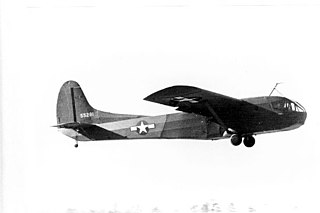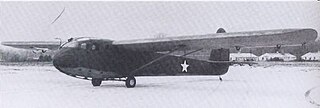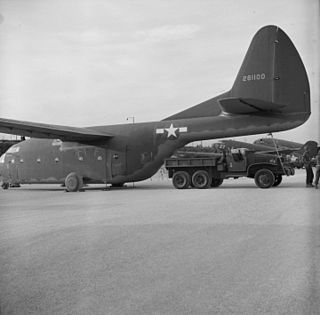
Military gliders have been used by the militaries of various countries for carrying troops and heavy equipment to a combat zone, mainly during the Second World War. These engineless aircraft were towed into the air and most of the way to their target by military transport planes, e.g., C-47 Skytrain or Dakota, or bombers relegated to secondary activities, e.g., Short Stirling. Most military gliders do not soar, although there were attempts to build military sailplanes as well, such as the DFS 228.

The Gribovsky G-11 was a Soviet light troop/cargo military glider of World War II.

The Antonov A-7 was a Soviet light troop military glider of World War II.
The Kolesnikov-Tsibin KC-20 or KTs-20 was a Soviet light troop military glider of World War II.

The Waco CG-15 was an American military glider, which was developed from the CG-4. Although outwardly similar to its predecessor and carrying the same number of passengers, a number of changes in the design, including shortened wings and a more streamlined nose enabled it to travel faster. 1,000 were ordered and 473 were delivered before production ceased. Two were transferred to the Navy for testing as the XLR2W-1. One unit was converted into an XPG-3 powered glider which used two Jacobs R-755-9 radial engines.

The Waco CG-3A was a US light troop military glider of World War II.

The Waco CG-4 was the most widely used American troop/cargo military glider of World War II. It was designated the CG-4A by the United States Army Air Forces, and given the service name Hadrian by the British.

The Chase XCG-18A and YC-122 Avitruc was a military transport aircraft designed by Chase Aircraft and produced in limited numbers in the United States in the late 1940s, initially as a glider, but definitively in powered form. The design was based on the CG-14 cargo glider but was substantially larger and featured all-metal construction. It was a high-wing cantilever monoplane. The fuselage was of rectangular cross-section and featured a loading ramp at its rear. The main undercarriage units were carried at the sides of the fuselage and were fixed, while the nosewheel was retractable. In its powered form, two radial engines were fitted in nacelles in the wings.

The Douglas XCG-17 was an American assault glider, developed by the conversion of a C-47 Skytrain twin-engine transport during World War II. Although the XCG-17 was successfully tested, the requirement for such a large glider had passed, and no further examples of the type were built; one additional C-47, however, was converted in the field to glider configuration briefly during 1946 for evaluation, but was quickly reconverted to powered configuration.

The Waco CG-13 was an American military transport glider aircraft developed during World War II.
The St. Louis CG-5 was a 1940s American prototype military transport glider designed and built by the St. Louis Aircraft Corporation.
The Frankfort CG-1 was a proposed Second World War American transport glider to be built for the United States Army, none were built and the programme was cancelled.
The Bowlus CG-8 was a prototype Second World War American transport glider to be built for United States Army, one was built but the type did not enter production and the programme was cancelled.
The Bowlus CG-7 was a prototype Second World War American transport glider to be built for United States Army, one was built but the type did not enter production and the programme was cancelled.

The Laister-Kauffman CG-10 was an American military transport glider aircraft developed during World War II.
The Snead LRH was a proposed amphibious transport glider design for the US Navy during World War II.
The Read-York CG-12 was a Second World War American transport glider designed for the United States Army.
The AGA Aviation CG-9, company designation AGA Aviation G.5 was a proposed Second World War American transport glider to be built for the United States Army Air Force (USAAF), none were built and the programme was cancelled.
The AGA Aviation LRG was a proposed amphibious transport glider design for the US Navy during World War II.
The Douglas CG-19 was a late 1940s assault glider project conceived by the Douglas Aircraft Company.








